(5467 products available)




































































































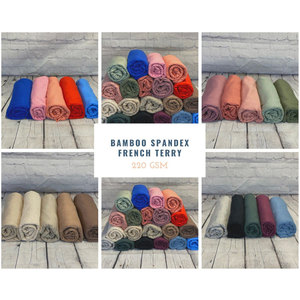
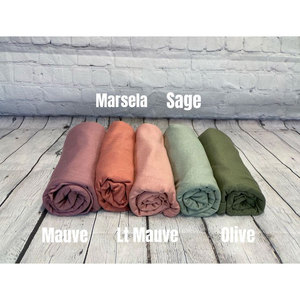
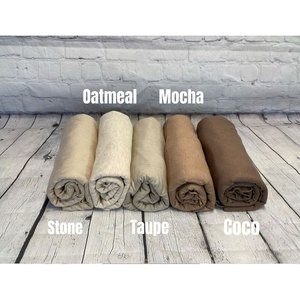
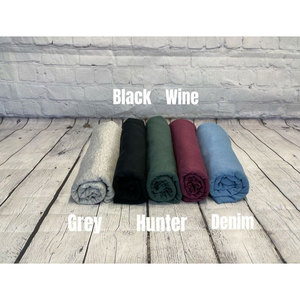
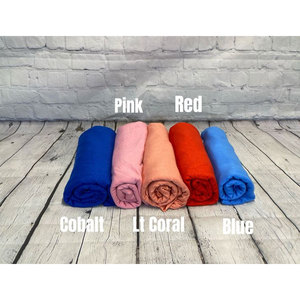

























































 Ready to Ship
Ready to Ship





Fabric is a flexible material composed of a weave or knit of fibers. These fibers can be made from natural or artificial sources. Generally, fabrics are utilized in sewing garments, making furnishings, and other related purposes. The term cloth by yard refers to a piece of fabric sold by a yard, which is an old measurement. The cloth comes in various types, as mentioned below:
Cotton Cloths by Yard:
These are natural cotton fiber-made fabrics. They are breathable, soft, and suitable for warm weather. There are different types of cotton fabrics, such as muslin, denim, poplin, sateen, and cotton lawn. All of them differ in weaving style, thickness, and texture.
Linen Cloths by Yard:
These are made from flax plant fibers and are one of the oldest natural fabrics. They are valued for their durability, freshness, and ability to absorb moisture. They have a classic, wrinkled look due to their relaxed weave.
Wool Cloths by Yard:
Wool fabrics come from animal hair, such as sheep. They are warm, elastic, and moisture-wicking. Wool is ideal for colder climates. People can find different types of wool fabrics, such as felt, tweed, and worsted.
Synthetic Cloths by Yard:
These are man-made fabrics created using polymers. They are usually less expensive than natural fabrics. People can find popular types like polyester, nylon, acrylic, and spandex. They are stain-resistant, easy to clean, and generally more robust.
Blended Cloths by Yard:
Sometimes, manufacturers create blended fabrics by combining natural and synthetic fibers. The goal is to offer the best features of both fiber types. Popular blended fabrics are poly-cotton and linen-rayon blends.
Silk Cloths by Yard:
These are made from the cocoon threads of silkworms. Silk is a luxurious, smooth, and vibrant fabric with a natural sheen. It is suitable for formal wear and delicate garments.
Denim Cloths by Yard:
This is a sturdy cotton twill fabric, famously known for making jeans. Denim has a diagonal rib pattern. It is durable and often used in casual and workwear.
Yardage
Clothes sold by the yard are available in different yardages. Some suppliers offer a yard of cloth, while others offer two or three yards of the same material. Some customers may demand more than one yard of cloth to make a large outfit or sew multiple pieces. Suppliers that provide more than one yard of cloth can serve both ends of the market. However, a single yard of cloth is sometimes sufficient for making simple outfits like skirts or dresses.
Patterns and Prints
When buying cloth by the yard, consider the pattern and print. Cloth manufacturers make different types of patterns on their fabrics and cloths. Some popular patterns are floral prints, geometric designs, polka dots, and striped patterns. Cloths with unique patterns and prints attract more customers than those with simple patterns. Buyers should choose cloths with unique patterns that will be visually appealing to the target audience. When selecting cloths for a specific purpose, consider how well the patterns match. For example, plaid patterns may not match well when joined together, creating a disjointed look.
Design Elements
The design of clothes sold by the yard may have various elements such as lace, trims, embellishments, and borders. These design elements are incorporated into the yardage or sold separately for consumers to add them to their cloths. Some consumers may prefer to use these design elements to create unique pieces. Yard cloths with these design elements can be appealing to the target audience and give them a unique appearance.
Color
The color of a cloth is an important factor that can influence buying decisions. Cloth colors evoke different emotions and can be suitable for different occasions. For example, dark colors like black and navy blue are suitable for formal occasions, while bright colors like red, yellow, and green can be worn for casual events. Some colors are in fashion, while others go out of fashion; cloth buyers pay attention to color trends to know which colors will appeal to their customers. Some buyers also prefer to select neutral colors that can blend with any other color.
Width
The width of yard cloth can determine how buyers use it. Cloth manufacturers make different widths, and the width can influence how people make garments with the yardage. Some garments require more width, while others need less. When choosing yard cloth, consider the width and see if it will serve the intended purpose.
Buying cloth by the yard is a versatile solution. It finds use in many industries. These are some of the popular scenarios.
Fashion Design:
Fashion designers need yards of cloth. They use it to make new clothes. Designers pick colors. They also pick patterns and textures. Then, they create seasonal collections. These collections include dresses, skirts, tops, and outerwear. Designers need many kinds of cloth. They need cotton, silk, linen, and wool. These types are suitable for different climates. They also are suitable for different occasions.
Costume Creation for Theatre and Film:
Theatre and film productions need cloth by the yard to create costumes. The costumes match the characters. They also match the historical period or fantasy setting. Large quantities of cloth are needed. These are for period costumes. They often need intricate details. They use velvet for period dramas. They also use burlap for rustic looks.
Home Decor Projects:
People who do DIY home decor projects buy cloth by the yard. They use it to make curtains, throw pillows, and tablecloths. Cotton and linen are popular choices. They are for items that need frequent washing. They stand up to wear and tear well. Upholstery projects also need cloth. They need a durable fabric. It withstands the heavy use of furniture.
Crafting and Quilting:
Crafters and quilters need cloth by the yard. They use it to make quilts, crafts, and clothing. They use cotton cloth. It is easy to work with. It is suitable for many crafting projects. Quilters often buy solid colors and prints. They use them to create beautiful quilt patterns.
Medical and Scientific Applications:
In the medical field, professionals buy cloth by the yard for many uses. They need it for making bandages, surgical gowns, and masks. Researchers also use cloth in labs. They use it for experiments and equipment covers.
Automotive Industry:
The automotive industry uses cloth by the yard. They use it to make car seats, curtains, and seat covers. The industry uses cloth that can resist stains and withstand wear. The airline industry needs cloth, too. It uses cloth to make seats and other interior parts.
Military and Defense:
The military and defense industry use cloth by the yard. They use it to make uniforms, tents, and gear. The industry needs cloth that can withstand harsh weather. They also need cloth that can withstand rough handling.
Wholesale buyers of fabric need to consider many things before selecting the cloth. They should know the qualities of the fabric and the needs of the customers. Here are some important things to consider when selecting fabric by the yard.
Purpose and End Use:
Understand the intended use of the fabric. Is it for clothing, upholstery, or crafts? Fabrics for garments need to be comfortable and durable. Upholstery fabrics need to be easily maintained and resistant to wear. Fabrics for crafts can have a wide range of qualities.
Fabric Content and Fiber Properties:
Know the different fibers and their qualities. Natural fibers like cotton and linen are breathable. They are good for clothes and bedsheets. Man-made fibers like polyester and nylon are strong. They resist stains and wrinkles. Blended fabrics combine the good qualities of both natural and man-made fibers.
Fabric Construction:
Understand fabric construction. It affects the cloth's look, feel, and performance. Woven fabrics have threads going in different directions. They are strong and have various textures. Knit fabrics have loops of yarn. They stretch and fit well. Know the weave patterns, like twill, satin, and plain, to choose the right fabric.
Quality and Durability:
Check the fabric quality. Look for even stitching and no defects. Higher-quality fabrics last longer and give better value over time. Consider the fabric's durability for its use. For high-use items, choose fabrics with higher thread counts and stronger fibers.
Care and Maintenance:
Consider how easy the fabric is to care for. Some fabrics need special care, while others are easy to wash. Easy-to-care-for fabrics are better for items like children's clothing or public area upholstery.
Trend and Color:
Follow trends to know what colors and patterns will sell. Use color swatches to match and select coordinating colors. Consider the fading resistance of the fabric. Some dyes and prints resist fading better than others.
Sustainability:
Think about the environmental impact of the fabric. Choose sustainable fabrics, like organic cotton or recycled polyester. Be ready for the rising demand for eco-friendly products as customers become more aware of the environment.
Regulations and Standards:
Know the safety rules for textiles. Ensure the fabrics meet standards for things like flammability and harmful substances. Comply with regulations to keep customers safe and avoid legal issues.
Supplier Relationship:
Build good relations with fabric suppliers. They should be reliable and open to discussing things. A good supplier will help buyers understand fabric trends and give samples for testing.
Q1: What are the benefits of buying a yard of cloth?
A1: Buying a yard of fabric is cost-effective, especially for projects needing a large amount of material. It also allows users to store extra fabric for future use or to create matching or coordinating items.
Q2: How can users ensure they get the right color when ordering cloth by the yard online?
A2: Colors can vary from one screen to another, so users should check the retailer's fabric return policy before ordering. Some retailers offer fabric swatches to help users choose the right color.
Q3: What should users consider when choosing a fabric for their project?
A3: Users should consider the material, how it feels, the fabric's durability, and how easy it is to clean. They should also ensure the cloth suits their project and will last as long as they want it to last.
Q4: Can users wash cloths by the yard before using them?
A4: Some fabrics can shrink or lose their color when washed, while others are colorfast and won't shrink in the wash. Users should check the care instructions before washing their fabrics.
Q5: What is the minimum amount of fabric users can buy by the yard?
A5: Cloth by yard suppliers usually have a rule that users must buy a certain minimum amount of fabric. The minimum can differ by supplier, so users should ask before ordering.
The keyword "cloth by yard" exhibits a significant fluctuation in web search volume, with an average monthly web search volume of 49,500. Over the past year, the keyword experienced a dramatic peak in August 2024 with 301,000 web searches, followed by a substantial drop to 246,000 web searches in September 2024, and then a sharp decline back to 8,100 web searches by October 2024. This indicates a highly variable trend with extreme highs and lows.
Analyzing the monthly data in more detail, "cloth by yard" maintained a relatively stable web search volume of around 9,900 from December 2023 to July 2024, except for a notable increase in July to 18,100 web searches. The peak in August 2024 suggests a seasonal or event-driven spike, which sharply decreased in the following months. By November 2024, the web search volume had returned to its baseline of 9,900, reflecting the pre-peak levels.
This pattern of web search volume for "cloth by yard" suggests that external factors, such as seasonal buying habits or specific market events, heavily influence consumer interest. The sharp decrease of 96% in the last three months and the zero percent change over the year highlight the volatility and unpredictability of consumer interest in this category. The extreme peak in August 2024 stands out as an anomaly, possibly tied to a specific demand surge or promotional activity that temporarily boosted interest in fabric purchases by the yard.